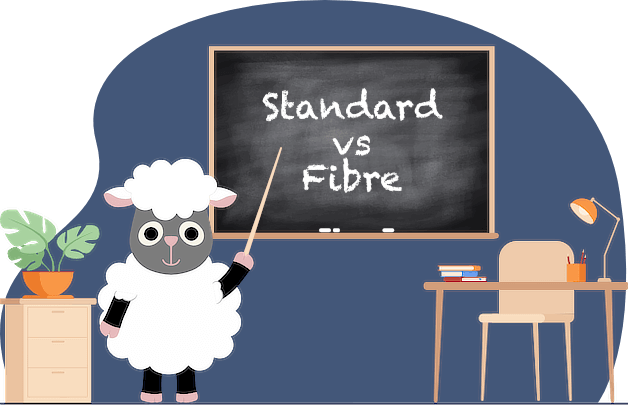Standard ADSL and fibre broadband are two of the main types of broadband connection in the UK. We take a deeper look at the main differences between them so you can decide which one is right for you.
What is standard broadband?
Standard broadband is the most widely available broadband connection on the market. Sometimes referred to as ADSL, which stands for Asymmetric Digital Subscriber Line, standard broadband is delivered to your home via copper telephone lines.
What is fibre broadband?
Fibre broadband is delivered to your home through fibre optic cables. Most fibre connections are FTTC, which stands for fibre to the cabinet. This is when fibre optic cables are used from the exchange to the cabinet on the street, then the rest of the connection into your home is provided by copper phone lines.
Increasingly, providers are rolling out fibre to the home (FTTH) connections. This uses fibre optic cables for 100% of the network, all the way to your house. The downside is it is not yet widely available.
What are the main differences between standard and fibre broadband?
Speed
The biggest difference between standard and fibre broadband is the speed. The old copper telephone lines used for standard broadband simply cannot transmit data as fast as fibre cables can. As well as this, the speed can slow down over distance, so the further you live from the exchange the slower your connection will be.
Average standard broadband speeds are around 10-11Mb, compared to FTTC connections which offer average speeds of around 35Mb or 65Mb. Virgin Media customers can expect even higher speeds due to using their own network of cables. FTTP connections can be as fast as 1Gb, though availability is still limited.
Availability
The Ofcom Connected Nations 2021 report (published December 2021) shows that around 96% of homes have access to superfast broadband (at least 30 Mb). FTTH lags behind with just over 28% (eight million) UK homes now able to access full fibre connections. This is an increase of 10 percentage points or three million premises in the past year, and the number continues to grow. This also doesn’t include providers that use their own network, such as Virgin Media who covers around 60% and growing all the time.
A pledge for FTTH and gigabit-capable broadband to every home and business in the UK by 2025 was made by Prime Minister, Boris Johnson in the 2019 general election. Though this was recently scaled back and now aims to connect 85% of premises by 2025, it’s still worth checking in periodically to see if you can now access FTTH.
Cost
If you are happy with entry level fibre speeds, so around 36Mb, then you’ll find that prices are generally not much more than standard broadband.
If you are looking for the faster connections then you can expect to pay a premium for this. However, it is always worth shopping around to see what deals are on. Special offers and promotions can mean the faster packages become more affordable.
Which is best?
So which one is best for you?
This depends on a few factors like how you use your connection and how many people are in your family.
Given how widely available fibre broadband is, and how prices are pretty much on a par with standard, it’s hard to see why anyone would opt for standard broadband over fibre.
That said, if you live alone and only browse the web and use social media occasionally, then you should find that standard broadband is enough for you and you’d probably rather save those few extra pounds a month.
For families who have multiple devices online at the same time, all doing different things, then it is better to go with fibre as this will offer a much faster, smoother and more reliable connection. If your family is doing a lot of really data heavy activities like downloading video games, then you may want to consider opting for a faster fibre package than the entry level.
Ultimately the right option for you means weighing up your average usage and finding the speed which is going to cover this without being overkill. We certainly wouldn’t recommend paying for 1Gb capable broadband simply because it’s available to you if you never need anywhere near these speeds.
View all broadband deals